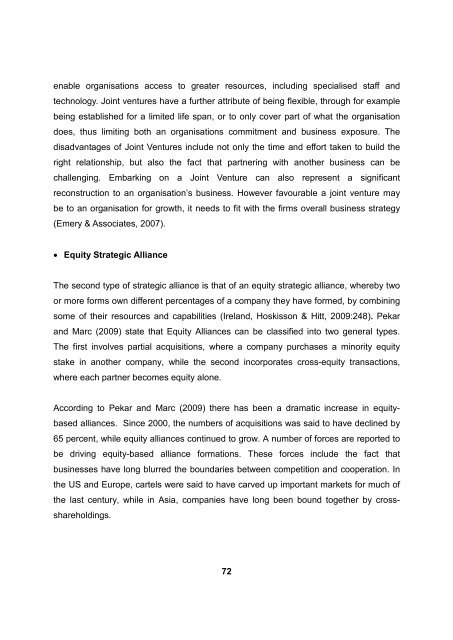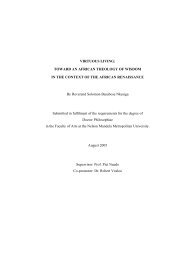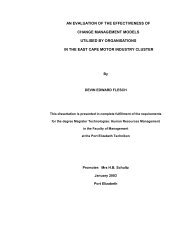enable organisations access to greater resources, including specialised staff andtechnology. Joint ventures have a further attribute of being flexible, through for examplebeing established for a limited life span, or to only cover part of what the organisationdoes, thus limiting both an organisations commitment and business exposure. Thedisadvantages of Joint Ventures include not only the time and effort taken to build theright relationship, but also the fact that partnering with another business can bechallenging. Embarking on a Joint Venture can also represent a significantreconstruction to an organisation’s business. However favourable a joint venture maybe to an organisation for growth, it needs to fit with the firms overall business strategy(Emery & Associates, 2007).• Equity Strategic AllianceThe second type of strategic alliance is that of an equity strategic alliance, whereby twoor more forms own different percentages of a company they have formed, by combiningsome of their resources and capabilities (Ireland, Hoskisson & Hitt, 2009:248). Pekarand Marc (2009) state that Equity Alliances can be classified into two general types.The first involves partial acquisitions, where a company purchases a minority equitystake in another company, while the second incorporates cross-equity transactions,where each partner becomes equity alone.According to Pekar and Marc (2009) there has been a dramatic increase in equitybasedalliances. Since 2000, the numbers of acquisitions was said to have declined by65 percent, while equity alliances continued to grow. A number of forces are reported tobe driving equity-based alliance formations. These forces include the fact thatbusinesses have long blurred the boundaries between competition and cooperation. Inthe US and Europe, cartels were said to have carved up important markets for much ofthe last century, while in Asia, companies have long been bound together by crossshareholdings.72
In recent years however, companies are said to have begun collaborating on anunprecedented scale. In the recent past, alliances tended to be merely tactical, forinstance, enabling a company to achieve its sales objective for individual exportmarkets. But today’s strategic partnerships are often more far-reaching in their scope.The global equity alliance mix has also significantly changed. From 1994 to 1996,technology companies dominated the mix, representing nearly 50 percent of all equityalliance formations (Pekar & Marc, 2009).• Non-Equity Strategic AllianceThe third type of strategic alliance is that of a non-equity strategic alliance in which twoor more firms develop a contractual relationship to share some of their unique resourcesand capabilities. In this type of alliance, firms do not establish a separate independentcompany; therefore do not take equity positions. Forms of non-equity strategic alliancesare said to include licensing agreements, distribution agreements, and supply contracts(Ireland, Hoskisson & Hitt, 2009:249). Culpan (2002) presents the major forms of nonequityalliances to include; licensing, franchising, management contracts, turn-keyoperations, subcontracting, buyer coalitions, supplier partnerships, research anddevelopment partnerships, marketing agreements, technology partnerships, and jointventures. Culpan (2002) explains however, that the list of “non-equity alliance forms” isnot all inclusive, as there may still be other types given the changing market conditions.According to Sarkar (2000), alliance proactiveness is likely to be directly associated witha firm’s market-based performance, defined in terms of sales growth, market share,product development, and market development. Sarkar (2000) further states thatalliance proactiveness is likely to result in first mover advantages, as early mover firmscapture advantageous positions in partner space. Alliances are argued to be moreeffective in providing governance mechanisms that facilitate the transmittal andcoordination of tacit knowledge flows (Madhok and Tallman, 1998). According to Pekarand Marc (2009) at present, the number of alliances being formed worldwide continues73
- Page 1 and 2:
CHAPTER 1SCOPE OF THE STUDY1.1 INTR
- Page 3 and 4:
1.3 RESEARCH OBJECTIVESThe primary
- Page 5 and 6:
) Qualitative Research“Qualitativ
- Page 7 and 8:
The respondents to be chosen need t
- Page 9 and 10:
• Living Standards Measure: It di
- Page 11 and 12:
2.2 INDUSTRY ANALYSIS2.2.1 Ethnic c
- Page 13 and 14:
grow in the forecast period. Men’
- Page 15 and 16:
cleans conditions and detangles whi
- Page 17 and 18:
In the general market, products are
- Page 19 and 20:
“all natural” claims by special
- Page 21 and 22: As a segment, this market sector ha
- Page 23 and 24: launching new Ethnic facial product
- Page 25 and 26: h) Skin Care products current and f
- Page 27 and 28: organic market, but are also breaki
- Page 29 and 30: (2000) asserts that Ethnic women no
- Page 31 and 32: experience time and time again. Pre
- Page 33 and 34: the government. The emerging black
- Page 35 and 36: Deodorant body sprays are particula
- Page 37 and 38: Euromonitor International One (2007
- Page 39 and 40: way, making it difficult to compete
- Page 41 and 42: and 2.14). As South African men bec
- Page 43 and 44: sales through those outlets is expe
- Page 45 and 46: Producers of mainstream skin care b
- Page 47 and 48: k) Sun Care Products current and fu
- Page 49 and 50: Trends and insights into South Afri
- Page 51 and 52: 2007:38). This expansion of distrib
- Page 53 and 54: CHAPTER 3STRATEGY FOR BUSINESS GROW
- Page 55 and 56: d) Improved SynergyImproved linkage
- Page 57 and 58: The market penetration strategy is
- Page 59 and 60: ) Gaining competitors' customers (P
- Page 61 and 62: power saw and a lady in a clown sui
- Page 63 and 64: Hoskisson and Hitt (2009:183) expla
- Page 65 and 66: Vertical integration is also claime
- Page 67 and 68: ) InternationalisationAnsoff (1965)
- Page 69 and 70: are described as non-equity based a
- Page 71: Another common reason for operating
- Page 75 and 76: isk than simply attempting to incre
- Page 77 and 78: Further advantages of diversificati
- Page 79 and 80: efficiency. Quantity discounts thro
- Page 81 and 82: CHAPTER 4FRANCHISING AS A GROWTH ST
- Page 83 and 84: Franchising is a commercial relatio
- Page 85 and 86: usually grants further licenses wit
- Page 87 and 88: Miranda (2009) further explains tha
- Page 89 and 90: The franchisee is said to carry a h
- Page 91 and 92: e) Competitiveness achieved through
- Page 93 and 94: franchise, and pay royalties on tim
- Page 95 and 96: of the franchise is what breeds pos
- Page 97 and 98: 4.6 CONCLUSIONIn this chapter franc
- Page 99 and 100: onset, which factors may cause cert
- Page 101 and 102: 5.3.1 ValidityIn its purest sense,
- Page 103 and 104: Speciality Top End, Ethnic Cosmetic
- Page 105 and 106: 5.4.2 Ethical AspectsWritten inform
- Page 107 and 108: Section three, deals with benchmark
- Page 109 and 110: Currently Mr Munroe is still occupy
- Page 111 and 112: ) Are current retailers situated in
- Page 113 and 114: e) Because of this move, is their s
- Page 115 and 116: concludes however that that there a
- Page 117 and 118: (2009) states that SA retailers are
- Page 119 and 120: Carter and Carter (2009) proclaim t
- Page 121 and 122: 6.3.5 Product RangingSection Five o
- Page 123 and 124:
According to The Free Library (2009
- Page 125 and 126:
The literature review reveals that
- Page 127 and 128:
BabyCarter and Carter (2009) explai
- Page 129 and 130:
(2009) also feels that such a niche
- Page 131 and 132:
Munroe (2009) also suggests mini LC
- Page 133 and 134:
) Do you see an interest from the f
- Page 135 and 136:
e) What services are the above reta
- Page 137 and 138:
h) Could current top end retailers
- Page 139 and 140:
Carter and Carter (2009) proclaim t
- Page 141 and 142:
A goal of Market Penetration Strate
- Page 143 and 144:
store to aid in the purchaser’s d
- Page 145 and 146:
Carter and Carter (2009) assert tha
- Page 147 and 148:
Carter and Carter (2009) proclaim t
- Page 149 and 150:
The literature review reveals that
- Page 151 and 152:
The Ethnic cosmetic and toiletry ma
- Page 153 and 154:
• Differentiation from competitor
- Page 155 and 156:
In terms of focus shown to the Ethn
- Page 157 and 158:
and brand reassurance, their desire
- Page 159 and 160:
c) Store design and layoutThe layou
- Page 161 and 162:
f) Promotional ActivitiesThe majori
- Page 163 and 164:
From the conclusions drawn, it was
- Page 165 and 166:
Available from:http://perfumesmelli
- Page 167 and 168:
Cosmetics Design. 2005. Black hairc
- Page 169 and 170:
Fortune Manning Lawyers. 2008. Freq
- Page 171 and 172:
LaPolt, E. K. 1997. Ethical dilemma
- Page 173 and 174:
Pearce, L . 2009. How to Take Your
- Page 175 and 176:
Stilwell, J. 2007. Strategies for B
- Page 177 and 178:
APPENDIX AQUESTIONNAIRE1. INDUSTRY
- Page 179 and 180:
4. GAINING MARKET SHARE AS A NEW EN
- Page 181 and 182:
c) How would you suggest a retail s
- Page 183 and 184:
f) Are current SA retailers who sto
- Page 185 and 186:
10. FUTURE OF THE ETHNIC COSMETICS
- Page 187 and 188:
10.Vetiver, woody notes (men and wo
- Page 189 and 190:
Table 2.9: forecast sales (in Milli
- Page 191 and 192:
Table 2.17: Forecast sales (in Mill
- Page 193 and 194:
Table 2.22: Forecast sales of Depil















